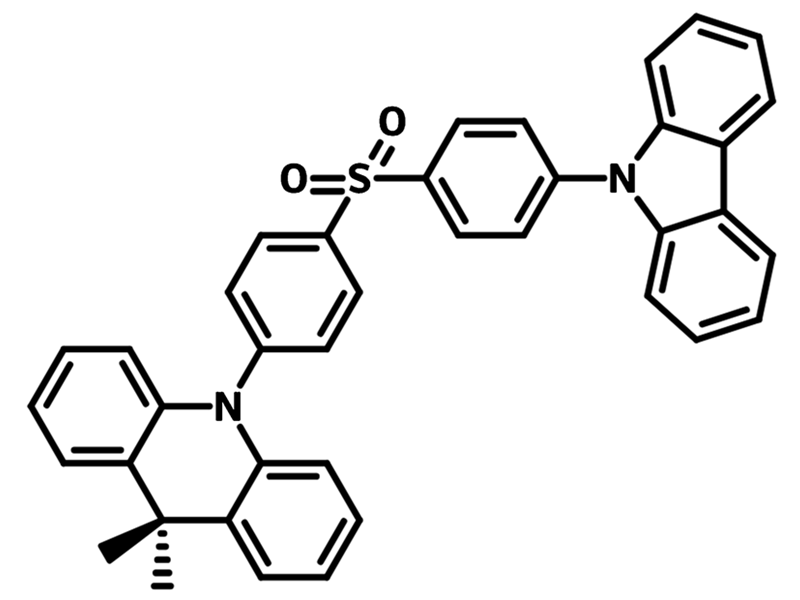CzAcSF
CAS Number 1792173-34-2
High Purity Sublimed Materials, Materials, OLED Materials, Semiconducting Molecules, TADF MaterialsCzAcSF, blue TADF dopant for highly efficient TADF-OLED devices
High-purity and available online for priority dispatch, 10-(4-(4-(9H-Carbazol-9-yl)phenylsulfonyl)phenyl)-9,10-dihydro-9,9-dimethylacridine, CAS No. 1792173-34-2, Sublimed ≥99.0%
CzAcSF is an unsymmetrical acridine derivative with one carbazole and one 9,9-dimethyl- 9,10-dihydroacridine attached to a diphenylsulfonyl center. CzAcSF is normally used as blue TADF dopant for highly efficient TADF-OLED devices. A quantum efficiency of 18.1% [1] has been achieved at a doping concentration of 0.1% TBPe in active emitting layer of DPEPO:CzAcSF.
CzAcSF can also be used as a bipolar host material to harvest singlet excitons of TBPe dopant material by a Forster energy transfer process. BFOXD-based devices exhibit better performances, with a maximum external quantum efficiency (EQE) of 20.1% while using CzAcSF as the host [2].
We stock high purity (>99%) CzAcSF and a range of other TADF materials and semiconducting molecules for priority dispatch (lead times may apply for large quantities). Qualifying orders ship free.
General Information
| CAS Number | 1792173-34-2 |
|---|---|
| Chemical Formula | C39H30N2O2S |
| Molecular Weight | 590.73 g/mol |
| Absorption | λmax 233 nm |
| Fluorescence | λem 443 nm in DCM |
| HOMO/LUMO | HOMO = 5.89 eV, LUMO = 3.00 eV; ET = 3.04 eV [3] |
| Full Chemical Name | 10-(4-(4-(9H-Carbazol-9-yl)phenylsulfonyl)phenyl)-9,9-dimethyl- 9,10-dihydroacridine |
| Synonyms | 10-(4-(4-(9H-Carbazol-9-yl)phenylsulfonyl)phenyl)-9,10-dihydro-9,9-dimethylacridine |
| Classification / Family | Acridine derivatives, Blue dopant materials, TADF host materials, sublimed materials |
Product Details
| Purity | Sublimed >99.0% (HPLC) |
|---|---|
| Melting Point | Tg = 117 °C |
| Appearance | Off white powder/crystals |
*Sublimation is a technique used to obtain ultra pure-grade chemicals. For more details about sublimation, please refer to the sublimed materials.
Chemical Structure

Device Structure(s)
| Device Structure | ITO (120 nm)/PEDOT:PSS (60 nm)/mCP (30 nm)/CzAcSF:0.3 w% TBPe (25 nm)/TSPO1 (5 nm)/TPBI (30 nm)/LiF (1 nm)/Al (200 nm) [4] |
|---|---|
| Color |
|
| Max. EQE | 15.4 % |
| Device Structure | ITO/PEDOT:PSS AI 4083 (40 nm)/CzAcSF:N2-8 (90∶10, 50 nm)/DPEPO (10 nm)/TmPyPB (50 nm)/Liq (1 nm)/Al (100 nm) [5] |
|---|---|
| Color |
|
| Max. Current Efficiency | 34.4 cd/A |
| Max. EQE | 17.6 % |
| Max. Power Efficiency | 27.0 Im/W |
| Device Structure | ITO/PEDOT:PSS AI 4083 (40 nm)/CzAcSF:N3-8 (90∶10, 50 nm)/DPEPO (10 nm)/TmPyPB (50 nm)/Liq (1 nm)/Al (100 nm) [5] |
|---|---|
| Color |
|
| Max. Current Efficiency | 43.1cd/A |
| Max. EQE | 18.9 % |
| Max. Power Efficiency | 27.1 Im/W |
Pricing
| Grade | Order Code | Quantity | Price |
|---|---|---|---|
| Sublimed (>99.0% purity) | M2271A1 | 100 mg | £260 |
| Sublimed (>99.0% purity) | M2271A1 | 250 mg | £520 |
| Sublimed (>99.0% purity) | M2271A1 | 500 mg | £850 |
| Sublimed (>99.0% purity) | M2271A1 | 1 g | £1400 |
MSDS Documentation
Literature and Reviews
- High efficiency blue fluorescent organic light-emitting diodes using a conventional blue fluorescent emitter, I. Lee et al., J. . Mater. Chem. C, 3, 8834-8838 (2015); DOI: 10.1039/C5TC01626F.
- Solution-Processed Highly Efficient Bluish-Green Thermally Activated Delayed Fluorescence Emitter Bearing an Asymmetric Oxadiazole–Difluoroboron Double Acceptor, D. Zhou et al., ACS Appl. Mater. Interfaces, 11, 27, 24339–24348 (2019); DOI: 10.1021/acsami.9b07511.
- Host Engineering for High Quantum Efficiency Blue and White Fluorescent Organic Light-Emitting Diodes, W. Song et al., Adv. Mater., 27, 4358–4363 (2015); DOI: 10.1002/adma. 201501019.
